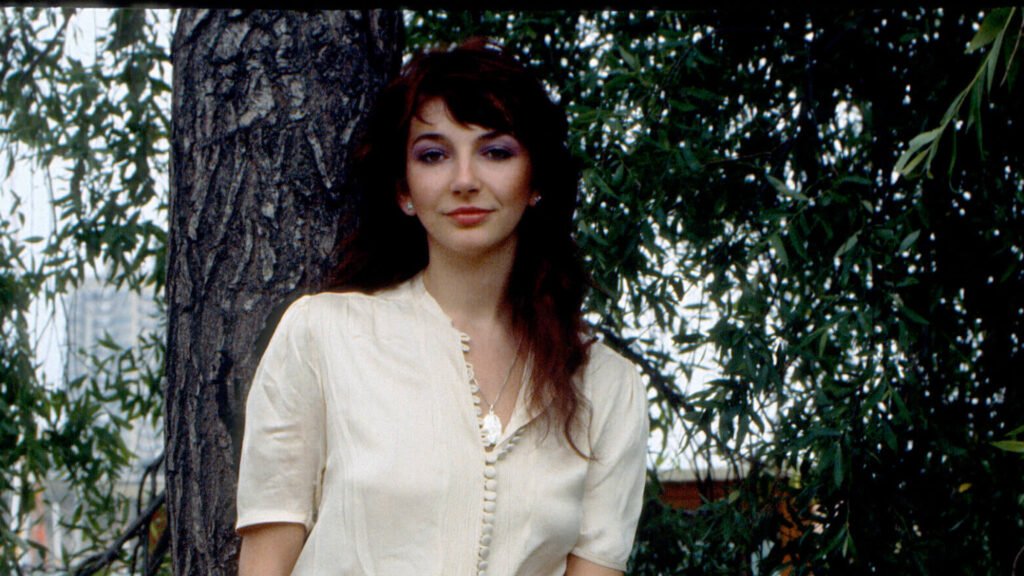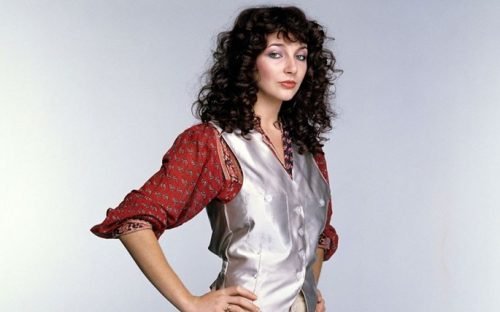In the pantheon of music legends, Kate Bush stands as a singular beacon of innovation and defiance. Emerging in the late 1970s, a time when the music industry was overwhelmingly male-dominated, Bush crafted a persona and musical style that defied easy categorization. With her debut single “Wuthering Heights” reaching the number one spot in the UK charts in 1978, she not only captured the public’s imagination but also broke the mold of what was expected from female performers. Her ethereal voice and eclectic sound, blending elements of art rock, pop, and avant-garde, heralded the arrival of a transformative figure in the music landscape.
Bush’s career is not just a tale of musical genius but also a narrative of relentless pursuit of artistic independence and control. This was a time when female artists were often marketed more for their appearances than for their musical talent, and creative control was a privilege reserved for their male counterparts.
Kate Bush shattered these industry norms and expectations, not just participating in the music scene but reshaping it entirely. Her boldness in managing her production and image laid down the gauntlet for the industry, setting the stage for future generations of female artists. This article explores how Kate Bush did not merely break the glass ceiling; she redefined it, inspiring a legacy of empowerment and innovation that transcends her era.
Defying Industry Norms

Entering the Scene
When Kate Bush released “Wuthering Heights” in 1978, she did more than just enter the music scene; she stormed it with a distinctive flair that was entirely her own. At just 19 years old, Bush became the first female artist to achieve a UK number one with a self-written song. The track, characterized by its haunting melodies and ethereal vocals, set her apart instantly from her contemporaries. This debut was not merely a musical release; it was a bold declaration of her unique artistic vision, challenging the conventional expectations of what female musicians could create and achieve.
Challenges in the Music Industry
The late 70s and early 80s were periods marked by significant gender disparity in the music industry. Female artists often faced immense pressure to conform to the commercial expectations of femininity and sexuality, typically shaped and dictated by male executives. These challenges were not only about image but also extended to artistic control and credibility. Women in music were frequently marginalized to the roles of performers rather than recognized as true creatives capable of writing and producing their own work.
Kate Bush confronted these barriers head-on. Her insistence on writing her own songs and involving herself deeply in the production process was revolutionary at a time when female agency in the arts was severely limited. She navigated a landscape riddled with sexism and skepticism, where her decisions to control her music videos, stage performances, and public image were seen not just as unusual, but radical. Bush’s approach to her career was a form of quiet rebellion against the industry’s norms, proving that female artists could command the same respect and autonomy granted to their male counterparts.
Artistic Independence and Control

Control Over Music Production
Kate Bush’s approach to music production was unprecedented for a female artist in her era. From the inception of her career, she exhibited a deep commitment to maintaining artistic control, a stance that was both rare and revolutionary. Starting with her debut album, The Kick Inside, Bush asserted her creative autonomy by writing all of the songs—a clear departure from the norm where female artists were often given songs to perform. This trend continued and expanded with her subsequent albums.
By the time she released her third album, Never for Ever, Bush had become the first British solo female artist to achieve a number one album and the first female artist to enter the album charts at number one. With The Dreaming, her fourth studio album, she took over as producer, breaking new ground again. This move allowed her to experiment with innovative soundscapes, pioneering the use of the Fairlight CMI synthesizer to create a more layered and complex auditory experience. Her hands-on approach in the studio was a testament to her mastery of the craft and her determination to let her vision, and not market trends, dictate the sound of her music.
Business Acumen
Beyond her artistic endeavors, Bush’s strategic decisions in managing her career demonstrated exceptional business acumen. Her independence from the typical constraints imposed by music labels was crucial. After her initial success, she negotiated more favorable terms that granted her greater creative freedom and control over her work, which was almost unheard of for artists at the time, particularly women.
Bush also pioneered a new model of engaging with the music industry. She took lengthy breaks between albums, focusing on quality and innovation over frequent releases, contrary to the industry’s usual push for regular album cycles to capitalize on market trends. This approach not only preserved her creative energy but also ensured that each project was a genuine reflection of her artistic evolution.
Moreover, Kate Bush’s decision to step back from the public eye and the touring scene after her only tour in 1979 allowed her to focus solely on her studio work, where she felt she could best express her artistic vision. Her management of her public image and media interactions was equally calculated. She was known for being selective about interviews and public appearances, which added to her mystique and allowed her to maintain control over her narrative and public persona.
Innovation as Rebellion

Musical and Lyrical Innovation
Kate Bush’s career is marked by a ceaseless quest for musical and lyrical innovation that profoundly challenged the norms of what female musicians were expected to produce. Her exploratory use of music technology set her apart in a genre that was still grappling with the potential of digital sounds and synthesis. Bush was among the first to harness the Fairlight Computer Musical Instrument, a pioneering piece of technology at the time, which allowed her to sample sounds and create a rich, layered effect that became a hallmark of her work, particularly evident in her album Hounds of Love. This technological adeptness enabled her to construct new sonic landscapes that defied traditional pop and rock formulations.
Lyrically, Bush ventured into themes that were seldom explored by her contemporaries. Her songs often wove complex narratives drawing on literary references, mythology, and personal introspection, ranging from the Brontëan echoes in “Wuthering Heights” to the psychological depths in “Running Up That Hill”. This approach not only diversified the content typically expected from female songwriters but also elevated the level of intellectual engagement in pop music.
Visual Artistry and Performance
In the realm of visual artistry and performance, Kate Bush again broke new ground, reshaping the expectations and roles of women in music. Her music videos were not mere promotional tools but elaborate artistic expressions that complemented her musical narratives. The video for “Cloudbusting,” inspired by Peter Reich’s book A Book of Dreams, stands out as a short cinematic piece that includes narratives of control, resistance, and freedom, extending beyond the typical scope of music video production at the time.
Bush’s contributions to expanding the visual and theatrical dimensions of musical performance were perhaps most dramatically realized in her 1979 tour, The Tour of Life. Featuring mime, magic, and multiple costume changes, the tour was a pioneering venture into what would now be recognized as total performance art. It prefigured many of the theatrical elements that would later become commonplace in the live performances of many artists. Her expressive use of body language and innovative choreography, often in collaboration with dancer Lindsay Kemp, challenged the conventional concert format and opened new avenues for narrative and expression in live music settings.
Legacy of Empowerment

Influencing Future Generations
Kate Bush’s influence on subsequent generations of musicians is profound and far-reaching, cutting across genres and borders. Artists as diverse as Björk, Florence Welch of Florence + the Machine, and St. Vincent have cited Bush as a pivotal influence on their work. Björk, whose eclectic style and avant-garde aesthetics echo Bush’s innovation, has spoken openly about the impact of Bush’s music on her own artistic development. Similarly, Florence Welch has acknowledged Bush’s influence in her theatrical approach to performance and the ethereal quality of her music. St. Vincent, known for her own innovative work and boundary-pushing performances, has also drawn inspiration from Bush’s artistic control and pioneering use of technology.
These artists, among others, have inherited Bush’s legacy of pushing musical boundaries and asserting artistic independence, reflecting Bush’s enduring impact on the landscape of contemporary music. Through their work, they continue to challenge the norms of what female artists can create and achieve, just as Bush did during her career.
Cultural Impact
Kate Bush’s achievements have had a ripple effect far beyond the confines of the music industry. By breaking the glass ceiling for female artists, she has helped change perceptions about the roles and capabilities of women in the music industry and beyond. Bush’s insistence on creative control and her success in traditionally male-dominated aspects of music production have served as a beacon for other women, signaling the possibilities of autonomy and leadership in their respective fields.
Moreover, Bush’s example has contributed to a broader cultural shift towards greater acceptance and recognition of women’s contributions in arts and entertainment. Her career challenges the stereotype of the female artist as merely a performer and redefines her as an innovator, a visionary, and a leader. The doors she opened have allowed more women to step into roles as producers, directors, and technology experts, areas once considered off-limits to them.
Through her music, performances, and the sheer force of her artistic will, Kate Bush has not only empowered individual artists but has also influenced the industry’s structural dynamics. The narrative she crafted through her career—one of empowerment, innovation, and independence—continues to inspire and influence, making her legacy one of enduring empowerment for artists and women worldwide.
